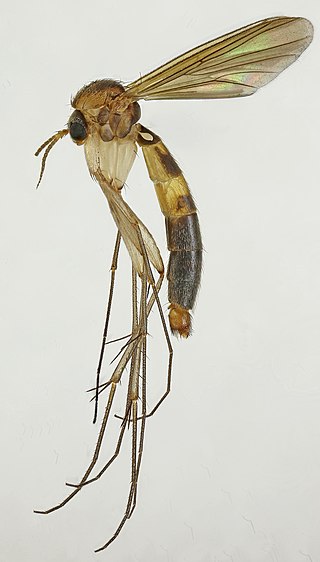Alsophila cincinnata, synonym Cyathea cincinnata, is a species of tree fern native to eastern New Guinea, where it grows at an altitude of 1300 m or higher. It is known only from a few collections in the Sepik region. The trunk is erect and short. Fronds are bi- or tripinnate and 1–1.5 m long. The stipe bears many glossy brown scales that have a distinctive black central band and dull edges. Sori are round, occur near the fertile pinnule midvein. They are covered by firm, brown indusia that are cup-like in appearance.

Oberea is a genus of longhorn beetles, most of which are stem borers of various plants, including blackberries and their relatives.

Clivina is a genus of ground beetle native to the Palearctic, the Nearctic, the Near East and North Africa. There are more than 600 described species in Clivina.
Menegazzia cincinnata is a species of foliose lichen from southern South America. It was first scientifically described by Swedish lichenologist Erik Acharius as Parmelia cincinnata. Friedrich August Georg Bitter transferred it to the genus Menegazzia in 1901.
Azamora penicillana is a species of snout moth in the genus Azamora. It was described by Francis Walker in 1863, and is known from Brazil and French Guiana.

The Aphrophoridae or spittlebugs are a family of insects belonging to the order Hemiptera. There are at least 160 genera and 990 described species in Aphrophoridae.

Acacia cincinnata, also known as the Daintree wattle or circle fruit salwood, is a species of leguminous trees of the plant family Fabaceae, found naturally in north eastern Australia.
Cincinnata allardi is a species of beetle in the family Cerambycidae. It was described by Breuning in 1966.

Cincinnata fasciata is a species of beetle in the family Cerambycidae. It was described by Karl Jordan in 1894. It is known from the Democratic Republic of the Congo, Cameroon, and Gabon.
Cincinnata konduensis is a species of beetle in the family Cerambycidae. It was described by Breuning in 1935. It is known from the Democratic Republic of the Congo.
Cincinnata schoutedeni is a species of beetle in the family Cerambycidae. It was described by Breuning in 1935. It is known from the Democratic Republic of the Congo.
C. cincinnata may refer to:

Passiflora cincinnata is a species of Passiflora from Brazil.
Kunzea cincinnata is a flowering plant in the myrtle family, Myrtaceae and is endemic to a small area on the south coast of Western Australia. It is a shrub which typically grows to a height of 0.6 to 1 metre and blooms between September and October producing pink to red-purple flowers.

Exechia contaminata is a Palearctic species of fungus gnat in the family Mycetophilidae. Exechia contaminata is chiefly or exclusively associated with Russula and Lactarius.

Exechia spinuligera is a Palearctic species of fungus gnat in the family Mycetophilidae. Exechia contaminata is chiefly or exclusively associated with Russula and Lactarius.

Exechia is a genus of fungus gnats in the family Mycetophilidae. There are more than 180 described species in Exechia.

Exechiini is a tribe of fungus gnats in the family Mycetophilidae. There are about 13 genera and at least 130 described species in Exechiini.
Amphixystis cincinnata is a moth of the family Tineidae first described by Edward Meyrick in 1915. It is found in Sri Lanka.

Exechia festiva is a species of 'fungus gnat' in the family Mycetophilidae.











